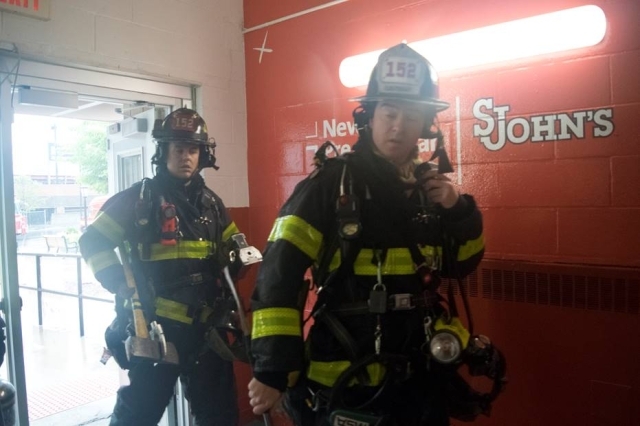
A daunting scenario was played out on St. John’s University’s Queens campus from 9 a.m. to noon on August 11, when fire, police, and medical and emergency personnel from St. John’s and New York City joined forces to execute a massive simulation of a disaster.
The drill: As a crowd of more than 5,000 cheers for the Men’s Basketball team at a game in Carnesecca Arena, an explosion rips through the boiler room two floors below, sending emergency responders scrambling to fight the smoke, help the injured, and lead others to safety.
“The main purpose of this type of exercise is to test and evaluate the ability of St. John’s Public Safety and supporting agencies from New York City to respond to a large-scale emergency and effectively deploy the needed personnel to save lives,” said Denise Vencak, Executive Director of Public Safety and Risk Management at St. John’s.
“We went through all of the motions as if they were actually happening,” she said. The fire alarm was activated, and the fire department was told that there was an explosion with 5,000 people involved. They determined the manpower and equipment, including 700 feet of fire hose that would be required. People were being evacuated out of the building and heading to their vehicles.
It took just three to five minutes for responders to arrive on campus—and that was the aim. “This great response time is one of the benefits of being in New York City and having these agencies right here to help us,” Ms. Vencak said. “Regardless of the emergency, we are going to have someone here in three to five minutes.”
Colleges and universities are required under federal law to annually test the effectiveness of their emergency management plans for various locations throughout their campuses. In addition to Public Safety, other St. John’s agencies that participated in the drill were the Department of Environmental Health and Safety, the Department of Athletics, and the Facilities Department. Participating New York City agencies were the Fire Department of the City of New York (FDNY), the New York City Police Department (NYPD), New York City Emergency Management, and the FDNY Emergency Medical Services (EMS).
More than 100 volunteers from the FDNY and the University, including students, were also involved in the drill. “We did not have 5,000 people, but we had enough to be able to play out the scenario and test everything that we needed to test,” Ms. Vencak said. “It is all a matter of quickly establishing control and deploying people in the right direction.”
Although the drill events are meticulously planned, timed, and communicated weeks in advance among participating agencies, responders still encountered a few intended surprises. For example, firefighters unexpectedly found “injured” boiler room workers—three 125-pound dummies in need of a simulated rescue.
“We always include some curve balls,” said Ms. Vencak. “We don’t want to divulge every detail of a drill scenario because our responders need to prepare for the real thing. Much of this is simply practice.”
Representatives of every participating agency met immediately after the drill to assess the actions taken during the exercise. “Overall, the drill went very well,” Ms. Vencak said. “It further bolstered Public Safety’s ability to successfully protect our students and the rest of the University community.”
